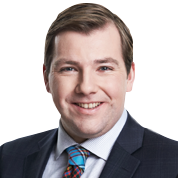LOS ANGELES — The skill and speed and smarts that will one day take William Nylander to the NHL aren’t all that’s required to ensure he succeeds at hockey’s highest level.
So as members of the Toronto Maple Leafs front office recently began pondering their top prospect’s development, they began to focus on the things he wouldn’t be able to work on in Sweden.
Nylander lived up to his billing as a dynamic offensive player during the 2015 World Junior Championships, but the Leafs brass noticed that he often put himself in vulnerable positions to get bodychecked. They also saw a lot of big looping strides — a direct product of playing on the larger international ice surface — rather than the quick stops and starts you need in the NHL.
So, with a negotiated deadline to bring him back to North America approaching on Friday, the Leafs elected to assign the 18-year-old forward to the American Hockey League.
“I think more than anything it’s having him under our system and playing the way we want him to play every day that’s most valuable in the second half,” Leafs assistant GM Kyle Dubas explained Monday at Staples Center.
One thing that didn’t concern the Leafs much was the disappointing season Nylander’s Swedish team, MODO, is currently limping through. They will be in tough to avoid relegation from the top tier of the Swedish Hockey League and recently changed coaches while Nylander was away at the World Juniors.
However, Toronto management seemed satisfied with how things were going in Ornskoldsvik, with Nylander playing more than 19 minutes a night and scoring 20 points in 21 games.
Multiple members of the Leafs’ front office have paid visits to Sweden, including Steve Staios, the player development advisor who spent four days with Nylander in November. He liked that MODO was using the teenager at centre and tried to reinforce key elements of the Leafs’ system during their time on and off the ice.
“With us being in there and feeding the prospects the information, showing them the video, hopefully the transition takes less time,” Staios told me last month.
Soon we’ll find out.
The Leafs are hoping to work through visa and immigration issues in time to have Nylander arrive in Toronto this weekend. The organization is targetting the Jan. 23 game in Hamilton for his debut, according to Dubas.
Nylander will be used at both centre and on the wing with the Marlies, and will likely have to absorb a couple of big hits while adjusting to his new surroundings. At least that’s what Nazem Kadri — a former highly-skilled prospect who played 130 AHL games — predicted.
Kadri’s advice for Nylander was simple: “Use your feet and then use your smarts.”
“He can think the game, he can skate, you know he’s got all of that skillset behind him,” said Kadri. “You’ve got to give him a little time to get used to it and then we’ll see him blossom.”
The Leafs are in absolutely no rush.
At this point, the odds of Nylander becoming an NHL regular out of next year’s training camp seem fairly remote. Should the team go through injuries or a slump in the coming weeks, he won’t even be considered an option to be recalled.
“Right now, there’s not a chance,” said Dubas. “We need to be patient. We can’t live and die with if he has a good weekend, and I know and I fully expect that the media will continue to ask after every good weekend he has, ‘is he going to come up?’ And the answer will be no.
“We need to be patient, develop him properly, and have him be able to come when he’s able to sustain being an NHL player, rather than come up and then go back down and just be more scattered than the season already has been.”
The best-case scenario for Nylander is finding a way to challenge that notion. If he plays well enough for long enough there might be some temptation for Leafs management to bring him up for a brief look before the end of the year.
The only thing they really have to concern themselves with is the 10-game threshold that would burn the first season of his entry-level contract. As a result, it’s inconceivable that Nylander would get in more than nine NHL games this year no matter how well he performs in the AHL.
In the shorter term, the organization is focused on helping him work through the inevitable adjustment that will come with playing pro hockey in North America. On Monday, one member of the front office predicted that it will be tougher than Nylander is expecting — a sentiment that was later echoed by Kadri.
“It’s not going to be easy, that’s for sure,” he said. “I mean it wasn’t easy for me either, but I just kept kind of battling through it. … I’ve been playing the game my whole life, so I knew how to play.
“It was just a matter of playing the right way.”
Even for top prospects, fully grasping that idea only comes after proper instruction and time.
